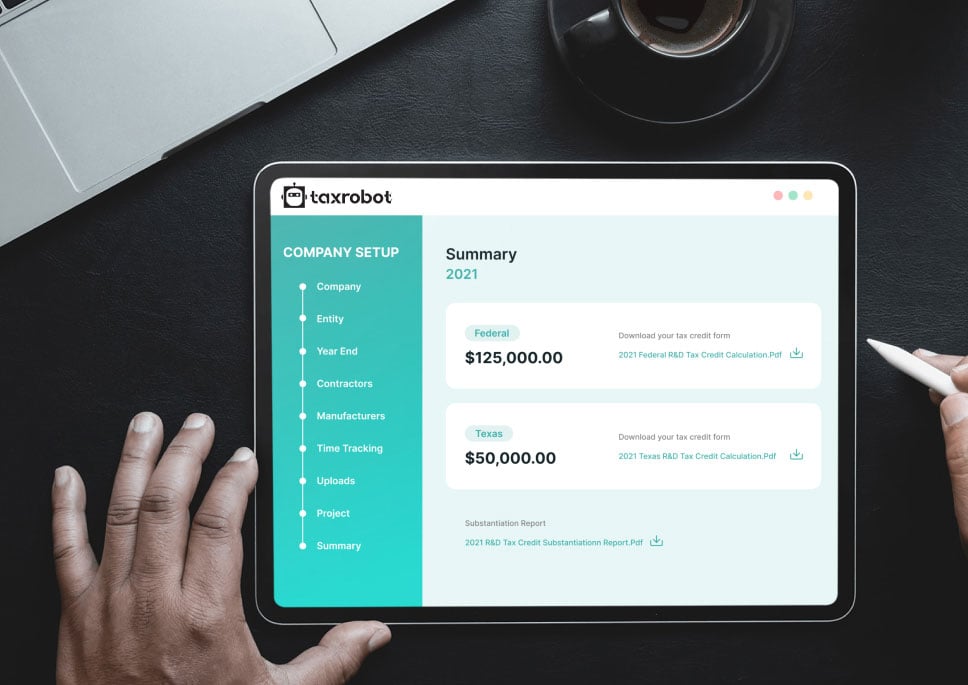Utah R&D Tax Credit
With Tax Robot, Utah R&D Tax Credit becomes more than a benefit—it becomes a catalyst for your business growth. Unleashing the incredible, simplifying the complex. This is not just tax planning; it’s financial evolution.
Maximize your State Credits today!
Put the R&D tax credit process on autopilot.
Trusted By:








Utah R&D Tax Credit
Discover your eligibility for Utah R&D tax credits and supercharge your enterprise.
Unlock the Full Potential of Utah R&D Tax Credits with TaxRobot
In today’s competitive business landscape, every financial advantage counts. Utah’s R&D Tax Credits are a golden opportunity you must consider.
These tax incentives are specifically designed to fuel innovation and growth within the Beehive State. Whether you’re a startup in the tech sector or an established manufacturing firm, these credits can significantly offset your R&D expenses, boosting your bottom line.
TaxRobot’s cutting-edge, AI-powered software demystifies the complex claiming process, ensuring you reap the maximum benefits with minimal hassle.
Don’t leave money on the table; let TaxRobot guide you through the labyrinth of Utah’s R&D Tax Credits.
What Are Utah R&D Tax Credits?
Understanding the intricacies of tax incentives can be a daunting task. Still, regarding Research and Development (R&D) Tax Credits in Utah, the benefits are too substantial to ignore.
These tax credits are a fiscal boon for companies engaged in qualified research activities within the state. Governed by Utah Code Section 59-10-1012, they mirror the federal Section 41 Credit for Increasing Research Activities, albeit with some state-specific nuances.
The Utah R&D Tax Credit is a non-refundable incentive to stimulate innovation and technological advancement across many industries—from healthcare and manufacturing to software development.
Eligible entities include C-Corporations, S-Corporations, LLCs, and Partnerships. The credit is calculated based on three key components:
- 5% of excess qualified research expenses (QREs) in Utah
- 5% of certain extra payments for basic research
- 7.5% of QREs for the current tax year
Businesses can significantly reduce their tax liability by leveraging these credits, freeing up
capital for further R&D endeavors or other strategic investments.
With TaxRobot’s AI-driven expertise, navigating this complex landscape becomes a streamlined experience.
How TaxRobot Simplifies the Utah R&D Tax Credit Process
Navigating the labyrinthine world of R&D tax credits can be a time-consuming and error-prone endeavor. That’s where TaxRobot comes in.
Our AI-powered software distills the complex claiming process into a seamless three-step journey:
- Provide Information
- Link Your Systems
- Receive Your Refund
By automating the intricacies of tax law and regulations, TaxRobot expedites the claim process and ensures unparalleled accuracy. Say goodbye to tedious paperwork and hello to audit-proof documentation.
With TaxRobot, you’re not just claiming Utah R&D Tax Credits but reclaiming your time and peace of mind.
Key Benefits of Using TaxRobot for Your Utah R&D Tax Credits
When maximizing your Utah R&D Tax Credits, TaxRobot offers unparalleled advantages.
Our AI-driven platform promises bigger refunds by identifying every eligible expense, ensuring you leave no money on the table.
Additionally, our software generates audit-proof documentation, mitigating risks and instilling confidence. But that’s not all; our value-based pricing model ensures you get premium service without breaking the bank.
TaxRobot transforms the often cumbersome process of claiming R&D credits into a streamlined, efficient, and financially rewarding experience. Choose TaxRobot, and invest in your business’s future with confidence.
Get Started Today with a Free Estimate
Why leave your R&D tax credits to chance when you can secure them with scientific precision? TaxRobot invites you to take the first step toward financial optimization with our no-obligation, free estimate.
Our AI-powered algorithms will give you an accurate projection of your potential tax savings, allowing you to make informed decisions.
With TaxRobot, claiming your Utah R&D Tax Credits becomes not just a possibility but a guarantee.
Take a sneak peak

- Limited Time Offer
- Simple Onboarding
- Easy to Use
R&D Tax Credits FAQs
The four-part test as outlined in the Internal Revenue Code is used to determine qualified R&D activity.
The Four-Part Test
1). New Or Improved Business Component
Creation of a new product, process, formula, invention, software, or technique; or improving the performance, functionality, quality, or reliability of existing business component.
- Construction of new buildings or renovation of existing buildings
- Invention of a software application
- Manufacturing of a new product or the improvement of the production process for an existing product
- Creation of design documentation
2). Technological In Nature
The activity fundamentally relies on principles of the physical or biological sciences, engineering, or computer science. A taxpayer does not need to obtain information that exceeds, expands or refines the common knowledge of skilled professionals in a particular field.
- Physics (relationship between mass, density and volume; loading as the
result of gravitational attraction) - Engineering (mechanical, electrical, civil, chemical)
- Computer science (theory of computation and design of computational systems)
3). Elimination Of Uncertainty
Uncertainty exists if the information available to the taxpayer does not establish the capability or method for developing or improving the business component, or the appropriate design of the business component.
- The capability of a manufacturer to create a part within the specified tolerances
- The appropriate method of overcoming unsuitable soil conditions during construction
- The appropriate software design to meet quality and volatility requirements
4). Process Of Experimentation
A process designed to evaluate one or more alternatives to achieve a result where the capability or method of achieving that result, or the appropriate design of that result, is uncertain as of the beginning of the taxpayer’s research activities.
- Systematic process of trial and error
- Evaluating alternative means and methods
- Computer modeling or simulation Prototyping Testing
The R&D tax credit is one of the most misunderstood tax incentives available. Considering the myriad of industries and activities that legally qualify for the credit, the term “research and development” is a misnomer. Additionally, the R&D tax credit requires specialized knowledge and technology to identify and calculate the incentive properly.
Companies of various industries are unaware that they are eligible to claim the R&D tax credit. Under the Internal Revenue Code’s definition of R&D, many common activities qualify. You can get tax benefits for industries including software, technology, architecture, engineering, construction, manufacturing, and more.
The R&D tax credit can be claimed for all open tax years. Generally, open tax years include the prior three tax years due to the statute of limitations period. In certain circumstances, the law allows businesses to claim the R&D tax credit for an extended period of time. It is common for companies to amend previous tax years to claim this benefit and reduce the maximum amount of tax liability.
Partnerships and S corporations must file this form to claim the credit. The credit will flow from the Form 6765, to the Schedule K-1, to the Form 3800 on the individual’s tax return. For individuals receiving this credit that have ownership interest in a partnership or S corporation, Form 6765 is not required on the individual return.
Individuals claiming this credit can report the credit directly on Form 3800, General Business Credit if their only source for the credit is a partnership, S corporation, estate, or trust. Otherwise, Form 6765 must be filed with the individual’s tax return (e.g. sole proprietorship).
For tax years prior to 2016, the credit can be used to reduce the taxpayer’s regular tax liability down to the tentative minimum tax. The credit cannot be used to offset alternative minimum tax. Beginning in tax year 2016, eligible small businesses have expanded utilization for the credit. For these eligible small businesses, the regular tax liability can offset alternative minimum tax using the “25/25” rule.
What our customers have to say
I highly recommend TaxRobot to anyone considering an R&D Tax Credit software to complete their analysis.

We decided to switch to TaxRobot… Best decision we’ve ever made. More affordable, and less complicated.

I couldn’t believe how easy it was! In under an hour, we saved enough money to hire a new employee.
